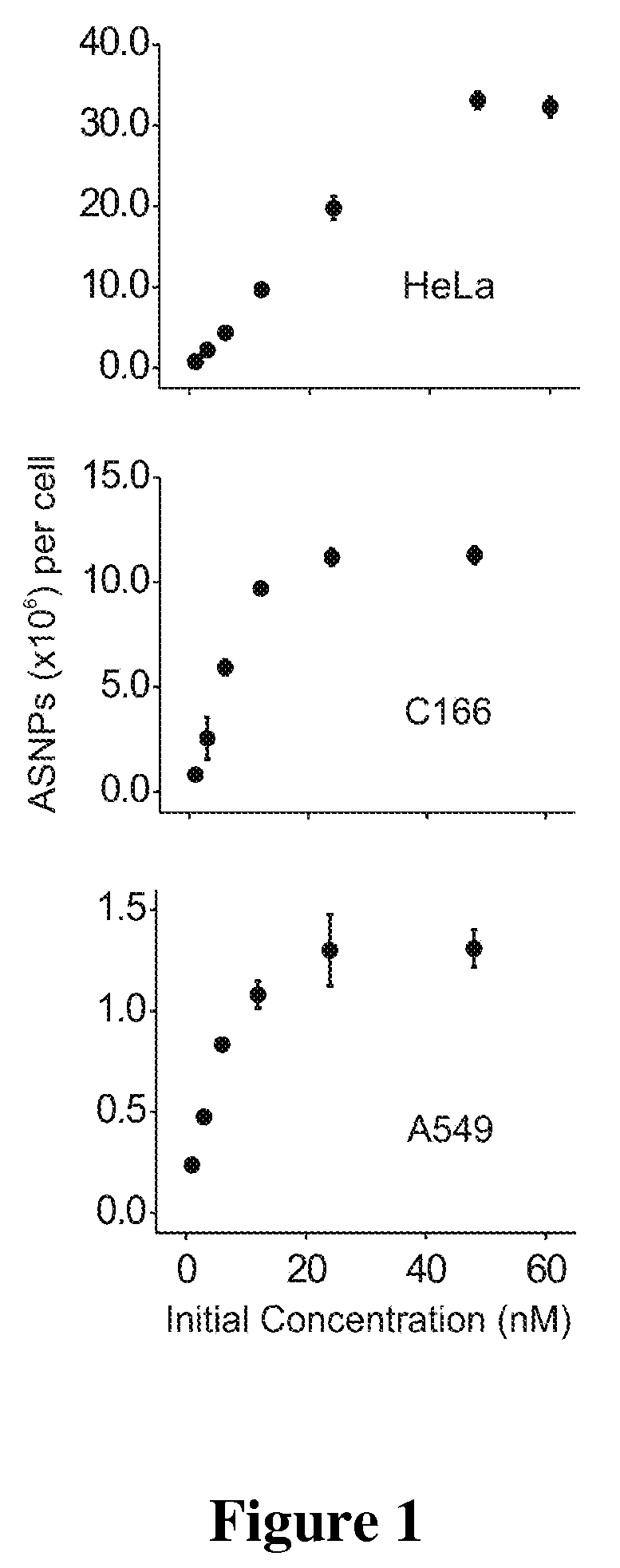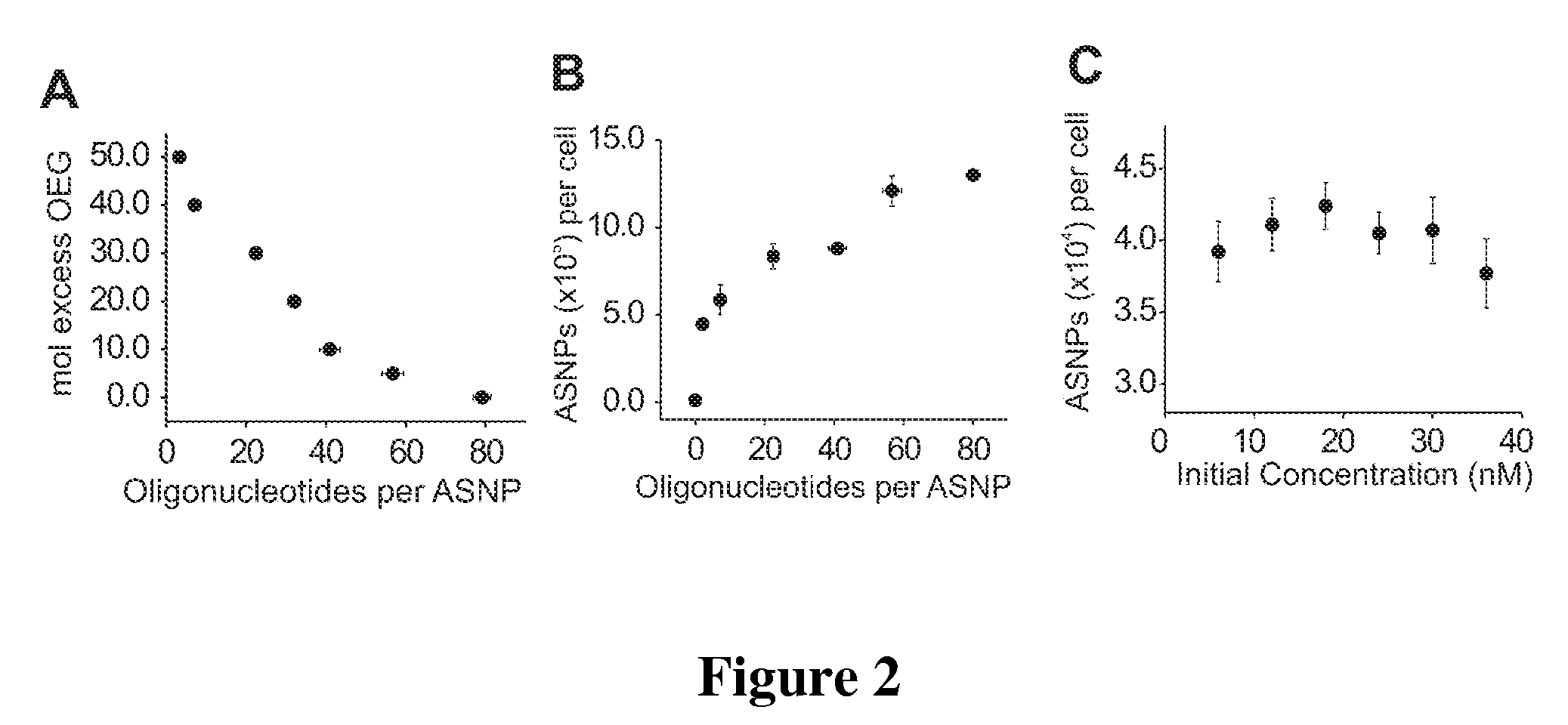Nucleic Acid Functionalized Nanoparticles for Therapeutic Applications
a technology of functionalized nanoparticles and nucleic acids, applied in the direction of drug compositions, biochemistry apparatus and processes, capsule delivery, etc., can solve the problem of increasing the toxicity of therapeutic agents, and achieve the effect of enhancing cellular uptak
- Summary
- Abstract
- Description
- Claims
- Application Information
AI Technical Summary
Benefits of technology
Problems solved by technology
Method used
Image
Examples
example 1
Preparation of Gold Nanoparticles
[0128]Citrate-stabilized 13 nm gold nanoparticles were prepared by reduction of HAuCl4 with citrate as described in Frens, Nature Phys. Sci., 241, 20 (1973) and Grabar, Anal. Chem., 67, 735 (1995). Briefly, all glassware was cleaned in aqua regia (3 parts HCl, 1 part HNO3), rinsed with Nanopure H2O, then oven dried prior to use. HAuCl4 and sodium citrate were purchased from Aldrich Chemical Company. An aqueous solution of HAUCl4 (1 mM, 500 mL) was brought to a reflex while stirring, and then 50 mL of a 38.8 mM trisodium citrate solution was added quickly, resulting in a change in solution color from pale yellow to deep red. After the color change, the solution was refluxed for an additional fifteen minutes, allowed to cool to room temperature, and subsequently filtered through a Micron Separations Inc. 0.45 micron nylon filter. Au colloids were characterized by UV-vis spectroscopy using a Hewlett Packard 8452A diode array spectrophotometer and by Tra...
example 2
[0129]To probe the general uptake of antisense oligonucleotide-modified gold nanoparticle agents (ASNPs) in cells, a mouse cell line (C-166) and two human cancer models (HeLa and A594) were examined. These cell lines were chosen to represent different species and inherent differences between cell and tissue types. Sterile filtered ASNPs were added directly to the cell culture media of adherent cells in concentrations ranging from 1 to 60 nM. Forty-eight hours after nanoparticle addition, the cells were washed 3 times in PBS buffer, collected, and counted using a Guava EasyCyte flow cytometer (Guava Technologies). To prepare samples for inductively coupled plasma mass spectrometry (ICP-MS) (Thermo-Fisher), the cells were dissolved with neat nitric acid at 60° C. overnight. The Au content of the cell digest was determined by ICP-MS. Each cell sample was prepared in a matrix consisting of 3% HNO3, 5 ppb Indium (internal standard), and Nanopure™ water. In order to extract the number of ...
example 3
[0131]Since the number of ASNPs associated with each cell was found to be higher than reported values for other modified Au NP systems, it was hypothesized that the oligonucleotides were strongly contributing to cellular uptake. To probe this contribution, particles with varying numbers of oligonucleotides were prepared by co-functionalizing them with OEG thiol diluent (FIG. 2A). OEG was chosen due to its charge neutrality, water solubility, and its ability to passivate surfaces in a manner that resists adsorption of biological molecules (Prime et al., 1991 Science 252(5009): 1164-1167). It should be noted that diluent molecules must be included in order to keep the Au NP surface fully passivated and the particles stable. This OEG diluent allowed ASNPs to be synthesized with zero to 80±2 oligonucleotides per particle that were stable under all the conditions required for cell culture. The stoichiometry during the functionalization process was varied to produce a range of DNA loading...
PUM
| Property | Measurement | Unit |
|---|---|---|
| Fraction | aaaaa | aaaaa |
| Fraction | aaaaa | aaaaa |
| Density | aaaaa | aaaaa |
Abstract
Description
Claims
Application Information
 Login to View More
Login to View More - R&D
- Intellectual Property
- Life Sciences
- Materials
- Tech Scout
- Unparalleled Data Quality
- Higher Quality Content
- 60% Fewer Hallucinations
Browse by: Latest US Patents, China's latest patents, Technical Efficacy Thesaurus, Application Domain, Technology Topic, Popular Technical Reports.
© 2025 PatSnap. All rights reserved.Legal|Privacy policy|Modern Slavery Act Transparency Statement|Sitemap|About US| Contact US: help@patsnap.com



